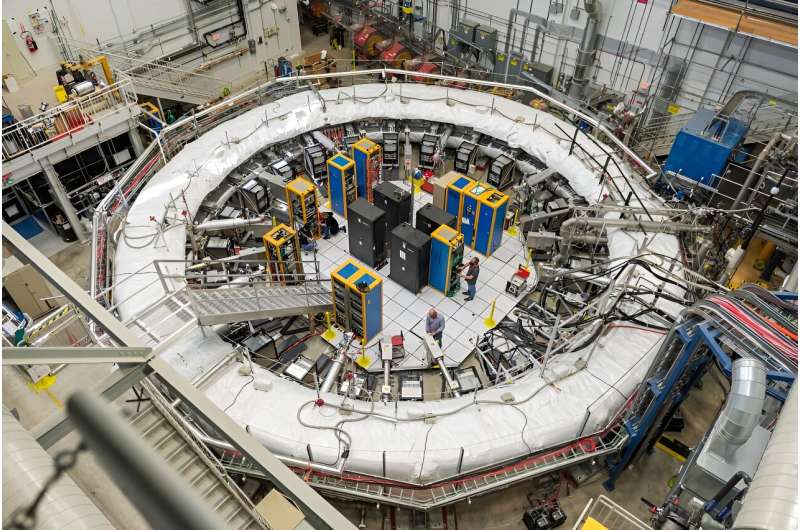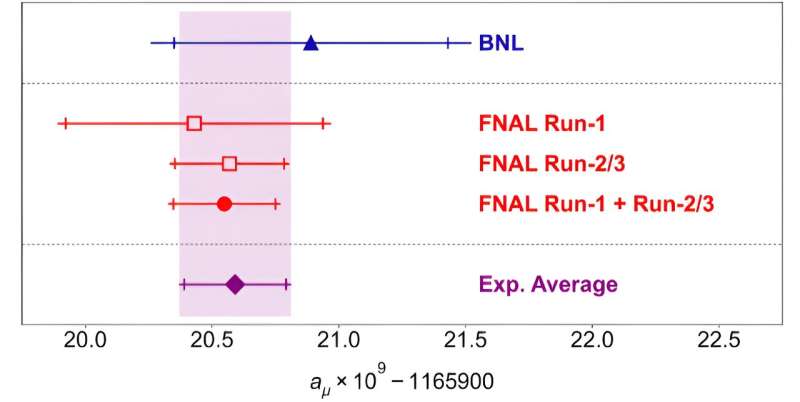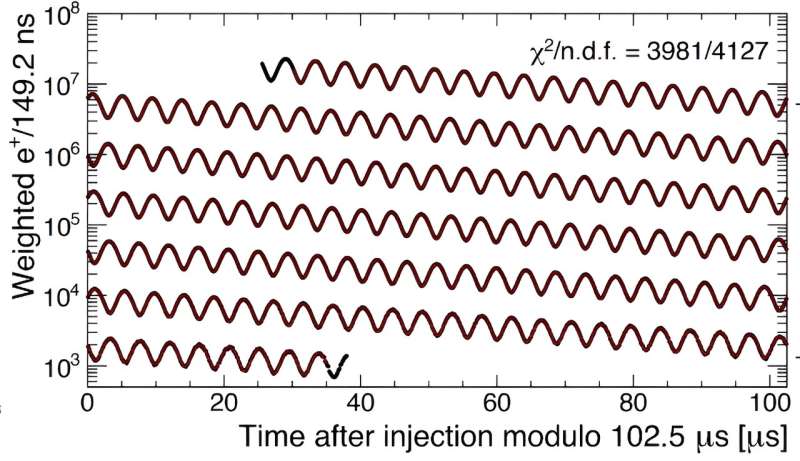November 8, 2023 feature
This article has been reviewed according to Science X's editorial process and policies. Editors have highlighted the following attributes while ensuring the content's credibility:
fact-checked
peer-reviewed publication
trusted source
proofread
Muon g-2 experiment measures the positive muon anomalous magnetic moment to 0.20 ppm

The Muon g-2 Collaboration is a large group of researchers at different institutes worldwide collaborating on the Muon g-2 experiment. This is a research effort aimed at exploring the interactions of muons, short-lived particles that are essentially heavy electrons, using powerful accelerators at the Fermi National Accelerator Laboratory (Fermilab).
The Muon g-2 Collaboration recently reported a new measurement of the so-called positive muon magnetic anomaly, based on the data collected at Fermilab between 2019 and 2020. This measurement is consistent with their previous measurements, while reducing error by over a factor of 2 due to improved experimental conditions.
The findings are published in the journal Physical Review Letters.
"The PRL paper is the next step in our goal of measuring the muon magnetic anomaly to a precision of 140 parts per billion," Andrew Edmonds, Assistant Professor at York College, City University New York and part of the Muon g-2 Collaboration, told Phys.org. "It builds on our previous result released in 2021 that had a precision of 460 parts per billion, and this result has a precision of 200 parts per billion. For reference, measuring the Statue of Liberty to 200 parts per billion is the equivalent of measuring it to 0.2 thousandths of an inch."
The muon magnetic anomaly is a value that represents the anomalous magnetic moment of muons. So far, there have been discrepancies between actual measurements of this value and theoretical predictions.

The reported differences between theoretical and measured values could be the result of a statistical fluke, rather than currently unexplained physics outside of the Standard Model. By collecting increasingly precise measurements, however, Edmonds and his colleagues hope to gain further clarity on this issue. If the result remains the same at increasingly greater precision, this could confirm that reported discrepancies are the result of physics beyond the Standard Model.
"We make this measurement by storing muons in a highly uniform magnetic storage ring with a diameter of 14 m," Edmonds explained. "The muons whizz around and around the ring and eventually decay to a positron (i.e., a positively charged electron). The positrons don't get stored and so hit our detectors on the inside of the ring. We count the number of positrons that hit the detectors and see an oscillation in the number of positrons."
To derive the muon magnetic anomaly, the Muon g-2 Collaboration ultimately combines the recorded frequency of the oscillation in the number of positrons with a highly precise measurement of the magnetic field. The measurement presented in their recent paper is the most precise to date, as the experimental conditions were improved, along with the stability of the particle beams.

"Our new measurement is consistent with previous measurements," Edmonds said. "This makes us more confident that we are measuring the correct value, and we are getting closer to being able to confirm whether or not the difference is a statistical fluke."
This recent paper by the Muon g-2 Collaboration is a further step towards confirming that the positive muon magnetic anomaly is influenced by physical processes outside of the Standard Model. The researchers are now analyzing their final data set, which will include all of the data collected over the six years in which the particle accelerators were running at Fermilab.
"The final data set contains 4 times more data than in our previous two measurements and so our precision should halve, and we can reach our 140 parts per billion goal," Edmonds said. "In the meantime, theorists are going to update their theoretical value of the muon magnetic anomaly and so we should have a final showdown between the experimental measurement and theoretical prediction in 2025 to confirm whether or not the difference is a statistical fluke or caused by physics beyond the Standard Model."
More information: D. P. Aguillard et al, Measurement of the Positive Muon Anomalous Magnetic Moment to 0.20 ppm, Physical Review Letters (2023). DOI: 10.1103/PhysRevLett.131.161802.
Journal information: Physical Review Letters
© 2023 Science X Network





















